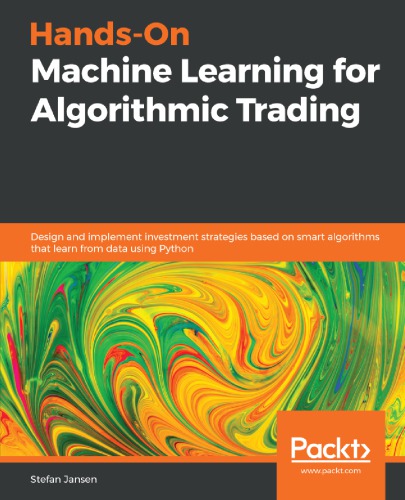Algorithmic trading relies on computer programs that execute algorithms to automate some, or all, elements of a trading strategy. Algorithms are a sequence of steps or rules to achieve a goal and can take many forms. In the case of machine learning (ML), algorithms pursue the objective of learning other algorithms, namely rules, to achieve a target based on data, such as minimizing a prediction error. These algorithms encode various activities of a portfolio manager who observes market transactions and analyzes relevant data to decide on placing buy or sell orders. The sequence of orders defines the portfolio holdings that, over time, aim to produce returns that are attractive to the providers of capital, taking into account their appetite for risk. Ultimately, the goal of active investment management consists in achieving alpha, that is, returns in excess of the benchmark used for evaluation. The fundamental law of active management applies the information ratio (IR) to express the value of active management as the ratio of portfolio returns above the returns of a benchmark, usually an index, to the volatility of those returns. It approximates the information ratio as the product of the information coefficient (IC), which measures the quality of forecast as their correlation with outcomes, and the breadth of a strategy expressed as the square root of the number of bets. Hence, the key to generating alpha is forecasting. Successful predictions, in turn, require superior information or a superior ability to process public information. Algorithms facilitate optimization throughout the investment process, from asset allocation to idea- generation, trade execution, and risk management. The use of ML for algorithmic trading, in particular, aims for more efficient use of conventional and alternative data, with the goal of producing both better and more actionable forecasts, hence improving the value of active management
چکیده فارسی
تجارت الگوریتمی متکی بر برنامههای رایانهای است که الگوریتمهایی را برای خودکار کردن برخی یا همه عناصر یک استراتژی معاملاتی اجرا میکنند. الگوریتم ها دنباله ای از مراحل یا قوانین برای رسیدن به یک هدف هستند و می توانند اشکال مختلفی داشته باشند. در مورد یادگیری ماشینی (ML)، الگوریتمها به دنبال یادگیری الگوریتمهای دیگر، یعنی قوانین، برای دستیابی به هدف مبتنی بر دادهها، مانند به حداقل رساندن خطای پیشبینی هستند. این الگوریتمها فعالیتهای مختلف یک مدیر پورتفولیو را رمزگذاری میکنند که معاملات بازار را مشاهده میکند و دادههای مربوطه را برای تصمیمگیری در مورد سفارش خرید یا فروش تجزیه و تحلیل میکند. توالی سفارشات، داراییهای پرتفوی را تعریف میکند که در طول زمان، با در نظر گرفتن تمایل آنها به ریسک، بازدهی جذابی برای تأمینکنندگان سرمایه ایجاد میکنند. در نهایت، هدف مدیریت سرمایه گذاری فعال، دستیابی به آلفا، یعنی بازدهی بیش از معیار مورد استفاده برای ارزیابی است. قانون اساسی مدیریت فعال، نسبت اطلاعات (IR) را برای بیان ارزش مدیریت فعال به عنوان نسبت بازده پرتفوی بالاتر از بازده یک معیار، معمولاً یک شاخص، به نوسانات آن بازده ها اعمال می کند. نسبت اطلاعات را بهعنوان حاصل ضرب ضریب اطلاعات (IC) تقریب میکند، که کیفیت پیشبینی را به عنوان همبستگی آنها با نتایج، و وسعت یک استراتژی را که به صورت جذر تعداد شرطها بیان میشود، اندازهگیری میکند. از این رو، کلید تولید آلفا پیش بینی است. پیشبینیهای موفق به نوبه خود نیازمند اطلاعات برتر یا توانایی برتر برای پردازش اطلاعات عمومی هستند. الگوریتمها بهینهسازی را در سراسر فرآیند سرمایهگذاری، از تخصیص دارایی گرفته تا ایدهپردازی، اجرای تجارت و مدیریت ریسک تسهیل میکنند. هدف استفاده از ML برای تجارت الگوریتمی، به ویژه، استفاده کارآمدتر از دادههای معمولی و جایگزین، با هدف تولید پیشبینیهای بهتر و عملیتر، در نتیجه بهبود ارزش مدیریت فعال است
ادامه ...
بستن ...
Author(s): Stefan Jansen
Publisher: Packt, Year: 2018
ISBN: 978-1-78934-641-1
ادامه ...
بستن ...










